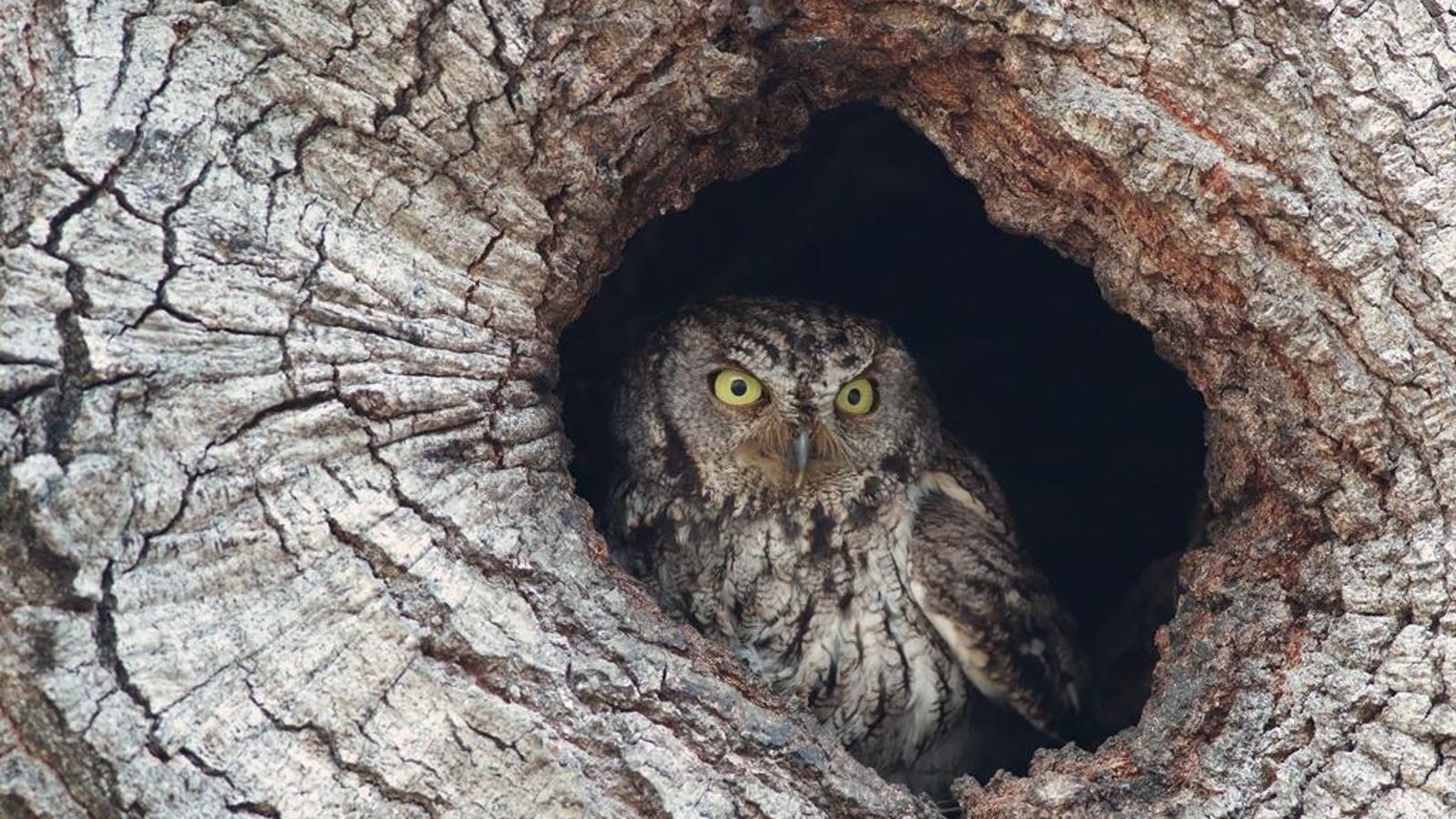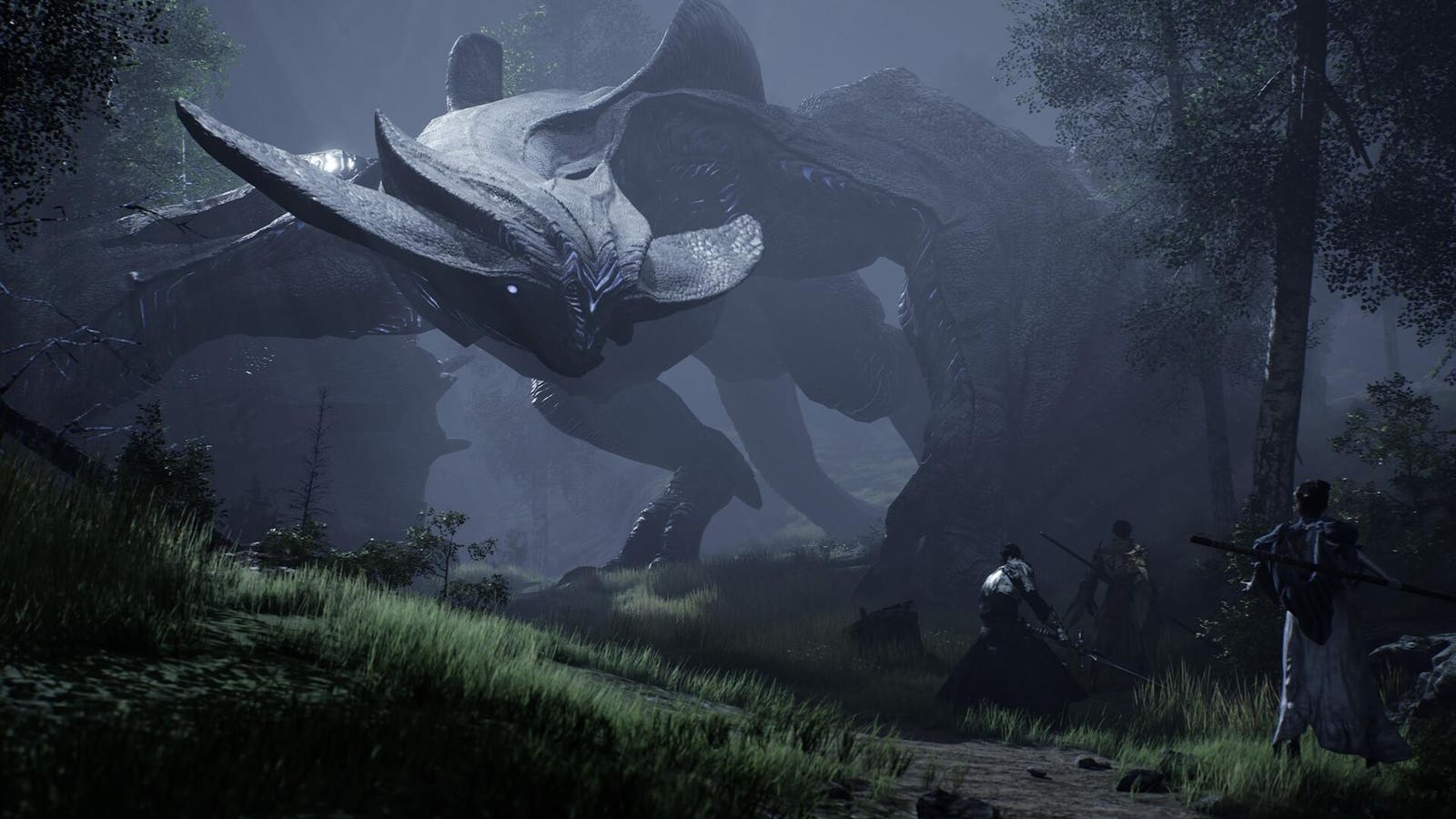Vertical hollow open-topped pipes used as property markers, fence posts or irrigation standpipes are killing countless birds and wildlife across the United States and around the world.
A Western Screech Owl (Megascops kennicottii) peers out of its nest hollow. This small owl species is a frequent victim of hollow “death pipes”. (Credit: Shravans14 / CC BY-SA 4.0)
Shravans14 via a Creative Commons license
Any hollow pipe or vent or sapling protector tubes with an interior diameter of 12 inches (30.5cm) or less is a threat to birds and wildlife. These hollow open-topped metal, PVC and plastic pipes are used throughout the world for a variety of purposes, such as property markers, mine claim markers, fence or sign posts, as irrigation standpipes or as abandoned wells. These pipes are attractive to wildlife, especially birds, because they look like safe places to build a nest or to roost for the night. But once a bird has entered, the pipe’s tight confines prevent it from extending its wings to fly out and the smooth circular interior makes it impossible to climb. As a result, these curious birds become trapped at the bottom of a tall pipe, inside sewer systems, septic tanks, or in other overlooked locations. But once a bird is inside, they can’t grip the walls to climb out or spread their wings to fly to freedom. Unable to escape, they slowly die of stress, dehydration or starvation. Then another bird spies this pipe, flies in to investigate and the killing starts all over again. For this reason, these pipes are often referred to as “Death Pipes”.
“ ‘Death Pipes’ (PVC, as well as metal fence posts) are known since the 1990s. Following this discovery, BLM issued warnings and instructions (e.g., cap open pipes),” said Aharon Sasson in email. Dr Sasson is a zooarchaeologist who serves as the co-director of the San Diego Zooarchaeology Laboratory in the Department of Birds and Mammals at the San Diego Natural History Museum.
Tragically for generations of wild birds, the simple instructions to cap open pipes were mostly ignored.
But cavity nesting birds are not the only victims of Death Pipes. Migrating birds may seek shelter from the elements in hollow pipes or attempt to roost on or in them and become trapped. But these Death Pipes not a new problem, so why is nothing being done to address this clear danger to wild birds and wildlife?
“We are asking ourselves the same question,” replied Dr Sasson in email. “Per my review of the literature, there is only a handful of peer-reviewed papers on this issue (compared, for example, with papers on bird-window collisions). Most of the conversation on death pipes has been carried out in newsletters of various conservation organizations (e.g., NRCS, Audubon, Fish and Wildlife and more),” Dr Sasson explained.
It is estimated that these Death Pipes are killing millions of birds, although so far, only a few of other quantitative analyses have been published.
“The American Bird Conservancy estimates that open-topped pipes may have killed over one million birds in Nevada alone, and potentially tens of millions across the western US (ref),” Dr Sasson warned in email. “Our goal is to get the word out through a meticulous study of over 100 pipes and a campaign led by the San Diego Natural History Museum.”
The pipe samples being examined by Dr Sasson and collaborators were provided by Peter Sanzenbacher of the U.S. Fish and Wildlife Service in Palm Springs, who kicked over 102 pipes in the eastern Mojave Desert and retrieved their contents.
“Our sample is large,” Dr Sasson said, “from a different area, and because we have the museum’s collection of bird skeletons as a reference, we are able to identify a far larger proportion of the sample than those who don’t know anything about bird skeletons and can identify birds from their external appearance only.”
Ash-throated Flycatcher (Myiarchus cinerascens). A common flycatcher of open arid areas of the West, the Ash-throated Flycatcher nests in holes in trees, fence posts, and nest boxes. (Credit: Teddy Llovet / CC BY-NC 2.0)
Teddy Llovet via a Creative Commons license
Dr Sasson’s ongoing studies indicate that open topped pipes pose significant dangers to local communities of birds and small animals, but he is finding that some species may be more common victims than others.
“Ash-throated Flycatcher is the most common victim in our study, so far (Minimum Number of Individuals, or MNI=55) and is a common victim in other publications on death pipes,” Dr Sasson reported.
“The second most common victim of the death pipes is the Loggerhead Shrike (MNI=25).” Dr Sasson went on to note that shrikes may be experiencing a phenomenon that he refers to as the “La Brea Pits syndrome”: They go into the pipes looking for dying prey and become trapped themselves.
Other small animals were identified in the study, but in smaller numbers compared to birds.
“We identified rodents (e.g., Desert Woodrat and various mice), bats (e.g., Myotis), reptiles (e.g., Horned Lizard) and insects (bees and others, yet to be identified),” Dr Sasson continued, then added: “It is also possible that mice and insects were accidentally dropped into these pipes by shrikes standing on top of the pipe.”
Loggerhead Shrike (Lanius ludovicianus). This predatory songbird is a surprisingly common victim of death pipes. (Credit: Jeffrey Gammon / CC BY 4.0)
Jeffrey Gammon via a Creative Commons license
At this point, it is difficult to know the full effects of Death Pipes on local wild bird and wildlife numbers because their contents are so rarely studied.
“[E]ven though we are studying just one set of samples, this one is so large, and there have been so few other quantitative studies – and none of them taking advantage of museum collections as a base for identifications – that our study should be a proportionately significant contribution to understanding the magnitude of the toll these pipes exact,” stated ornithologist Philip Unitt, who is Curator of Birds and Mammals at the San Diego Natural History Museum, and the editor of Western Birds, the quarterly flagship publication of the Western Field Ornithologists.
Death Pipes may have greater impacts upon species conservation concern, such as the Loggerhead Shrike.
“As far as the magnitude of the problem is concerned – its effect at the level of the population – we have no clear idea,” Professor Unitt said in email. “The species best represented in our samples that is of conservation concern rangewide is the Loggerhead Shrike, so mortality in the pipes could be compounding the other factors decimating the shrike.”
Other species identified in the Death Pipes are fairly common and thus, are not yet of conservation concern, although some, such as Western Screech Owls, were a bit of a surprise.
“Some of the species are well represented in our samples, like the House Finch and Rock Wren, are common,” Professor Unitt told me in email. “But I can see a local population being depleted, especially where natural nest sites are so few. Even more so with the Western Screech Owl, which was surprisingly numerous in our samples.”
A Rock Wren (Salpinctes obsoletus) perched on a rock in Granite Bay, California. Rock wrens are common victims in death pipes. (Credit: ADJ82 / CC BY 3.0)
ADJ82 via a Creative Commons license
According to the California Audubon, nearly 45 species of birds have been recovered from Death Pipes. In addition to flycatchers, shrikes and some owls, bird species commonly trapped include bluebirds, woodpeckers, sparrows, and kestrels. Further, a large variety of lizards, snakes, small mammals and a plethora of insects have also been found trapped inside pipes.
According to the California Audubon, the death toll from these pipes can be devastating. For example, they removed a 20 foot tall pipe in 2009 from an abandoned irrigation system. Just this one pipe yielded the carcasses of hundreds of birds and animals, including kestrels, flickers, bluebirds, and fence lizards that had become trapped over a time period of 50 years. All of these animals died slow horrible deaths.
Even worse, these Death Pipes can be found absolutely everywhere in the world. For example, I found around one dozen of these pipes within one mile of where I currently reside in Norway. (The smaller, shorter pipes used as property markers are now are filled with handfuls of gravel.)
There are several ways these Death Pipes can be dealt with. First, they can be covered at the top with permanent screens or concrete plugs or simply filled with gravel. They also can have holes cut at ground level to allow entrapped birds and wildlife to escape. Additionally, nest boxes should be erected near these Death Pipes to reduce their attractiveness to birds and thereby reduce competition for appropriate nest sites. But the best way to deal with these Death Pipes is to remove and replace them with safer designs that can’t trap birds or wildlife.
But there is another, more subtle, lesson to be learned from Death Pipes. Beyond the inherent immorality of thoughtlessly torturing and killing birds and wildlife, Death Pipes are an example of the hidden toll that people and their structures are exacting on nature.
“Just as birds did not evolve in a world with glass [windows], neither did they evolve in a world with slick-sided vertical pipes,” Dr Sasson said in email. “Makes you wonder how many other kinds of structures are responsible for hidden wildlife mortality.”
But now that we are becoming aware of this particular problem, we can address it.
“Human-caused mortality in birds is estimated in the billions,” Dr Sasson told me in email. “While other causes of death could be controversial or complicated to fix (e.g., cats, glass windows), open pipes are a rather easy fix, once we bring it the public’s attention.”
© Copyright by GrrlScientist | hosted by Forbes | LinkTr.ee
Socials: Bluesky | CounterSocial | LinkedIn | Mastodon Science | Spoutible | SubStack | Threads | Tumblr | Twitter









